i) Name the plant growth hormone which is synthesized at the shoot tip. Explain briefly why does a plant shoot bend towards light during its growth.
ii) With the help of a schematic diagram, trace the sequence of events occurring, when you step on a sharp object. Name this action.
OR
i) Compare and contrast nervous and hormonal mechanism for control and coordination in animals.
ii) a. Draw a diagram of the human brain.
b. The label on it cerebrum, cerebellum.
c. What is the role of the cerebellum?
When the movement in plants is growth dependent then it is called tropic movement. It is a directional movement in response to stimulus. For example:
Phototropism- Movement towards the direction of light. Example: Movement of shoot of plant upwards towards light.
Auxin hormone is synthesized at the shoot tip. Plant shoot bend towards light during its growth because plant hormone named auxin is present at the tip of shoot.
It is a growth promoting hormone.
• The primary function of the auxin hormones is to elongate plant cells in the stem. Auxin by some mechanism breaks the bonds holding its cellulose fibers together. These broken bonds give the cell wall greater flexibility and expandability, so that more water can enter the cell by diffusion, causing the cell itself to elongate.
• Auxins are also responsible for adventitious root development, secondary growth in the vascular cambium,
• Inhibition of lateral branching, and fruit development. In fact, seedless fruits can be artificially created by applying synthetic auxin to plants; this causes fruit to develop even though fertilization (and thus seed formation) has not occurred.
It can be explained by help of this diagram. This kind of movement is induced by light. The stem mostly grows and turns towards the source of light, therefore it is said to be positively phototropic. Auxin distribution controls phototropism.
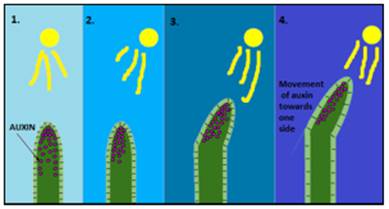
In 1, Sunlight strikes the plant from directly above. Auxin (pink dots) encourages growth straight up. In 2, 3, 4, Sunlight strikes the plant at an angle. Auxin is concentrated on one side, encouraging growth at an angle from the preceding stem. More growth of the stem on the shaded side is due to more accumulation of auxin on the shaded side than on the illuminated side.
This unequal distribution of auxins on the two sides may be due to following two reasons:
• Translocation of auxins from illuminated side to the shaded side.
Inhibition of auxin synthesis in the illuminated side (light side).
iii. The pathway of the reflex action is called Reflex arc. Reflex action is any spontaneous, involuntary and automatic response to a stimulus to protect us from harmful situations. For e.g. when a person touches a hot plate a sudden action leading to withdrawal of hand occurs in a certain manner, this path of manner determines the reflex arc.
The entire process of response to a peripheral nervous stimulation that occurs involuntarily is called a reflex action. It is defined as an inborn, involuntary mechanical response to stimuli. The reflex pathway comprises at least one afferent neuron and one efferent neuron appropriately arranged in a series. The afferent neuron receives signal from a sensory organ and transmits the impulse via a dorsal nerve root into the CNS. The efferent neuron then carries signals from CNS to the effector.
The sequences of events occurring when we step on a sharp object are:
• Nerve endings located in the leg identifies the irritant entered in the foot.
• Receptor sends the information or nerve impulse to the sensing (recognition) centre located in the brain stem.
• Brain stem sends instructions to the leg muscles for response.
• The muscle cells move by contraction and relaxation by utilizing the energy in the form of ATP. Muscle contraction is initiated by signals sent by the CNS to the muscle fibres. During contraction, the muscles fibres shorten, the muscle pulls on the ligaments that connect the bones and the movable body parts.
• Leg is moved apart from the sharp zone.
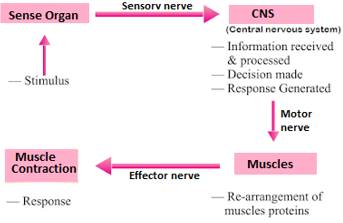
During relaxation the muscle fibres come to their original position. This movement of muscles cells or the muscle fibres results in the movement of the body parts.
The biggest difference between the two is that the nervous system uses electrical impulses to send signals through neurones, whereas the hormonal system uses chemical messengers transported into blood plasma to target cells. Transmission by the nervous system is short-lived but quick, whereas transmission by the hormonal system is long-lasting but takes much longer. This means that communication is faster when using the nervous system. In the nervous system, responses are localised - whereas in the hormonal system, they are widespread. Responses are often permanent in the hormonal system, but temporary and reversible in the nervous system.
• Nervous system is made of neurons whereas endocrine system is made of secretory cells called glands.
• In nervous system, the messages are transmitted in the form of electrical impulses whereas in endocrine system, the messages are transmitted in the form of chemicals called hormones.
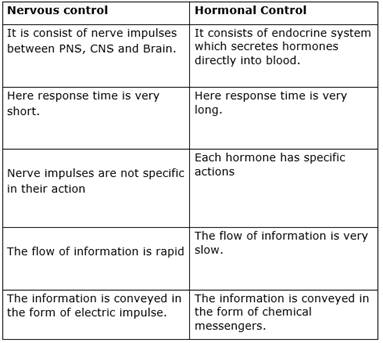
OR
Human Brain: It is enclosed in cranium (brain box) and is protected by cerebrospinal fluid which acts as a shock absorber. Human brain has three major parts or regions: (a) Fore-brain (b) Mid Brain (c) Hind Brain.
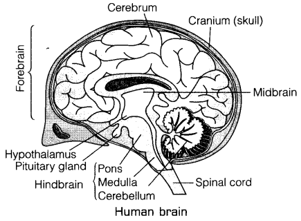
They also have components:
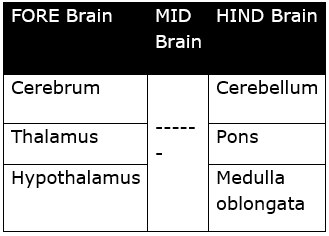
âFore-brain
It is the most complex/specialized part of the brain.
(A)Cerebrum-
(i) Main thinking and largest part of the brain.
(ii) It has 3 main areas:
a) Sensory area- to receive impulses from sense organs via Receptors
b) Motor area- control voluntary movements.
c) Association areas- Reasoning, learning & intelligence.
(B) Thalamus – It relays sensory information to the Cerebrum.
(C)Hypothalamus- It forms the link between Nervous system & Endocrine system.
â Mid brain- It connects the fore-brain with the hind-brain. It is the portion of the central nervous system associated with vision, hearing, motor control, sleep/wake, arousal (alertness), and temperature regulation.
â Hind brain- Connects the Fore brain & Hind brain
a) Cerebellum – Controls & coordinates muscular movements, maintaining body posture and equilibrium.
b) Pons- Acts as a bridge between brain & spinal cord
c) Medulla oblongata- Controls involuntary actions like blood pressure, salivation, vomiting, etc.
Function of cerebellum:
The cerebellum receives information from the sensory systems, the spinal cord, and other parts of the brain and then regulates motor movements. The cerebellum coordinates voluntary movements such as posture, balance, coordination, and speech, resulting in smooth and balanced muscular activity.
In case of damage to the cerebellum, while not causing paralysis or intellectual impairment, might lead to a lack of balance, slower movements, and tremors (shaking). Complex physical tasks would become unsteady and halting.